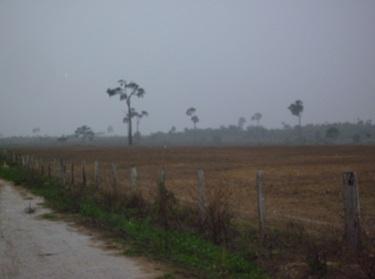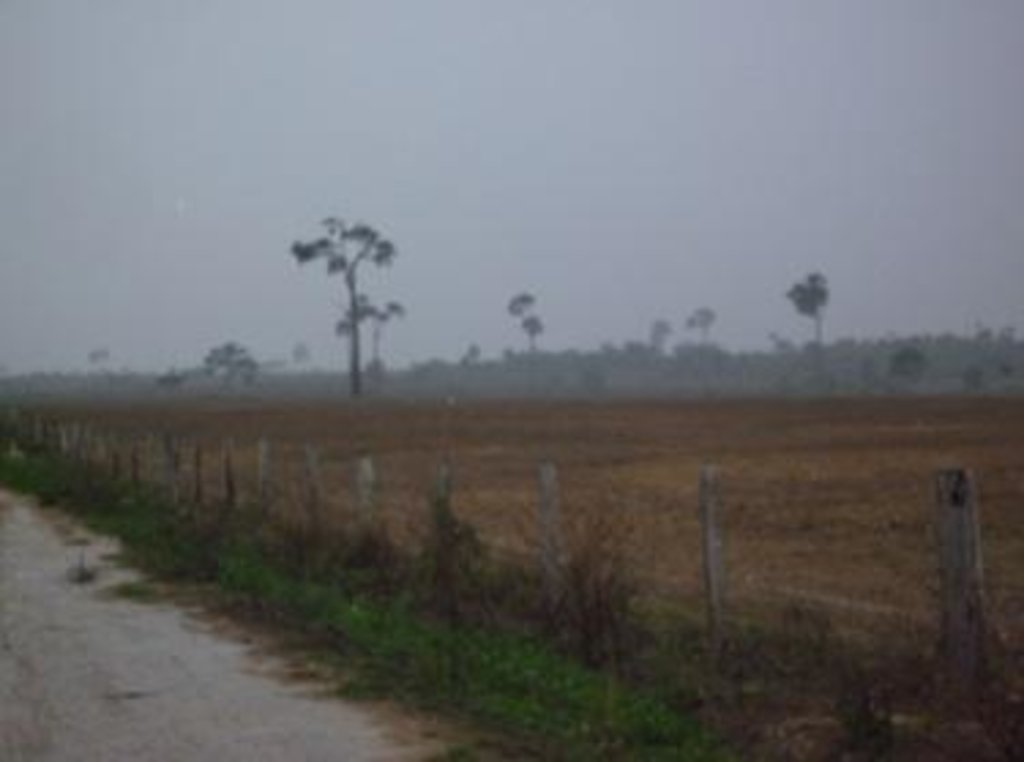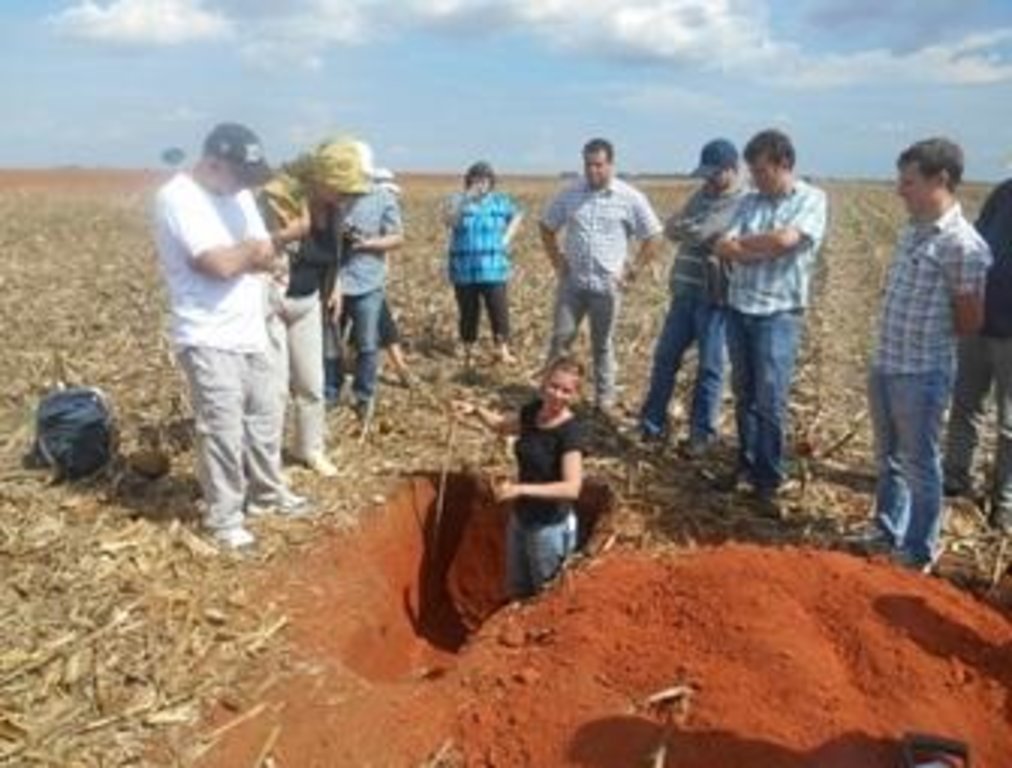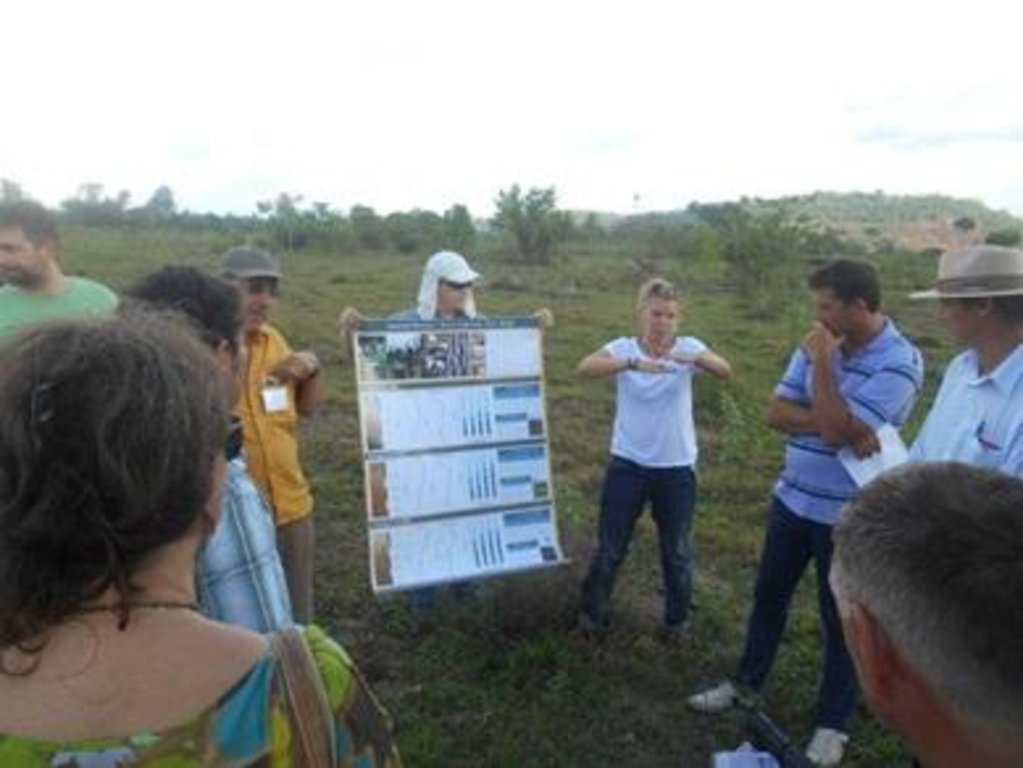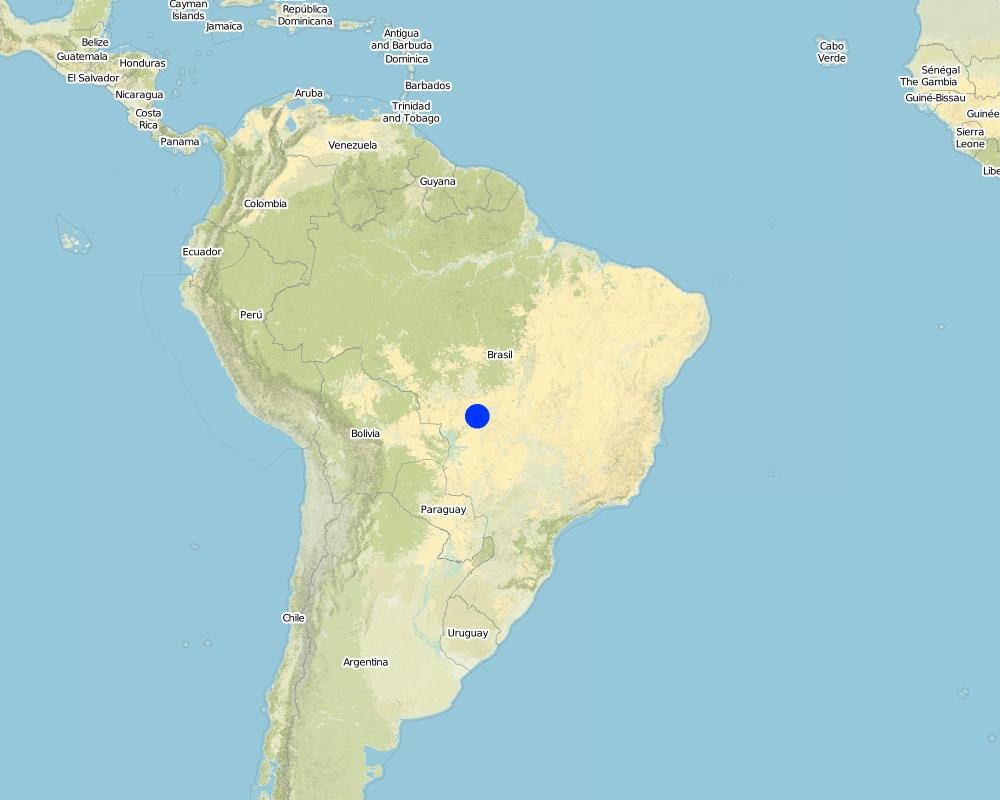Carbon stocks, turnover and nutrient budgets in soil along land-use and climatic gradients [บราซิล]
- ผู้สร้างสรรค์:
- การอัพเดท:
- ผู้รวบรวม: Stefan Hohnwald
- ผู้เรียบเรียง: –
- ผู้ตรวจสอบ: Fabian Ottiger
Estoque de Carbono
approaches_2529 - บราซิล
ดูส่วนย่อย
ขยายทั้งหมด ย่อทั้งหมด1. ข้อมูลทั่วไป
1.2 รายละเอียดที่ติดต่อได้ของผู้รวบรวมและองค์กรที่เกี่ยวข้องในการประเมินและการจัดเตรียมทำเอกสารของแนวทาง
วิทยากรหลัก
ผู้เชี่ยวชาญ SLM:
Strey Simone
Hoffmann@ifbk.uni-hannover.de
Institute of Soil Science, University of Hannover
Herrenhäuser Str. 2, 30419 Hannover
บราซิล
ผู้เชี่ยวชาญ SLM:
Strey Robert
Institute of Soil Science, University of Hannover
บราซิล
ผู้เชี่ยวชาญ SLM:
Boy Jens
Institute of Soil Science, University of Hannover
บราซิล
ผู้เชี่ยวชาญ SLM:
Guggenberger Georg
Institute of Soil Science, University of Hannover
บราซิล
ชื่อของโครงการซึ่งอำนวยความสะดวกในการทำเอกสารหรือการประเมินแนวทาง (ถ้าเกี่ยวข้อง)
Institute of Soil Science, University of Hannover - เยอรมนี1.3 เงื่อนไขที่เกี่ยวข้องกับการใช้ข้อมูลที่ได้บันทึกไว้ผ่านทาง WOCAT
วันที่เก็บรวบรวมข้อมูล (ภาคสนาม):
12/06/2015
ผู้รวบรวมและวิทยากรหลักยอมรับเงื่อนไขเกี่ยวกับการใช้ข้อมูลที่ถูกบันทึกผ่านทาง WOCAT:
ใช่
2. คำอธิบายของแนวทาง SLM
2.1 การอธิบายแบบสั้น ๆ ของแนวทาง
Find carbon optimized land management practices.
2.2 การอธิบายอย่างละเอียดของแนวทาง
การอธิบายอย่างละเอียดของแนวทาง:
Aims / objectives: (1) determine the native background stocks of N, P, K, Mg, Ca, and S in soil to a depth of 10 m in the native systems (rain forest and Cerrado).
(2) determine the temporal change in C and nutrient stocks using space-for-time substitution along the pioneer front gradient from central Mato Grosso to south Pará to assess the influence of land use on C and nutrient budgets.
(3) analyze the stocks of bulk C and of C in soil fractions differing in function and turnover to determine the influence of land use and soil management on distribution of SOM into different pools (i.e., analysis of the quantity and quality of C storage in soil).
(4) quantify the C turnover in these fractions by a combination of the stable C isotope and the 14C approaches (i.e., analysis of the sustainability vs. vulnerability of C storage in soil as affected by land use and soil management).
(5) assess the influence of climatic change on these parameters along the climatic gradient from central Mato Grosso to south Pará (i.e., analyze the sustainability vs. vulnerability of C storage in soil as affected by climate change).
(6) parameterize a C and N turnover model (e.g. CANDY, Rühlmann et al. 2006) at plot level and calculate different land-use and climate-change scenarios.
Methods: Analysing carbon stocks – sampling laboratory work (Elementar analyses).
Soil properties of the two most common soil types (texture, bulk density, pH, plant available nutrients, etc.).
Modelling– model the process of carbon storage after land-use change.
Stages of implementation: Transport into meanings – translate scientific results into recommendations for farmes which land-use type is most carbon friendly.
Role of stakeholders: Implementation of land use decision– depending on the soil properties.
2.3 รูปภาพของแนวทาง
2.5 ประเทศ ภูมิภาค หรือสถานที่ตั้งที่ได้นำแนวทางไปใช้
ประเทศ:
บราซิล
ภูมิภาค/รัฐ/จังหวัด: :
Mato Grosso, Pará
ข้อมูลเฉพาะเพิ่มเติมของสถานที่ตั้ง:
Novo Progresso, Sinop, Cuiabá
Map
×2.6 วันที่เริ่มต้นและสิ้นสุดของแนวทาง
ระบุปีที่เริ่ม:
2011
การสิ้นสุดลง (ถ้าแนวทางไม่ได้ใช้อีกต่อไป):
2016
2.7 ประเภทของแนวทาง
- ใช้โครงงานหรือแผนงานเป็นฐาน
2.8 เป้าหมายหรือวัตถุประสงค์หลักของแนวทาง
The Approach focused mainly on SLM with other activities (soil organic carbon pools)
Analyze the impact of different land use types on soil organic carbon storage after deforestation.
The SLM Approach addressed the following problems: the meaning of scientific results to farmers – there is no real importancy for them how much carbon is in their soil
The problem is that the whole climate change debate is based on Carbon, however by land use shift from rainforest to pasture or crop fields, soil organic carbon is not the parameter which is the most important, nevertheless is always in the focus if land-use change is discussed.
2.9 เงื่อนไขที่เอื้ออำนวยหรือเป็นอุปสรรคต่อการนำเทคโนโลยีภายใต้แนวทางนี้ไปปฏิบัติใช้
บรรทัดฐานและค่านิยมทางสังคม วัฒนธรรม ศาสนา
- เป็นอุปสรรค
They only do what they know – new ideas are hard to implement.
Treatment through the SLM Approach:
การมีไว้ให้หรือการเข้าถึงแหล่งการเงินและบริการ
- เป็นอุปสรรค
Small farmers have no money to manage their land carbon friendly.
Treatment through the SLM Approach:
กรอบแนวทางในการดำเนินการด้านกฎหมาย (การถือครองที่ดิน สิทธิในการใช้ที่ดินและน้ำ)
- เป็นอุปสรรค
Land titles are not clarified.
Treatment through the SLM Approach:
The existing land ownership, land use rights / water rights greatly hindered the approach implementation If farmers do not own the land by law they will not invest in protecting their land or invest in programs with duration over more than 5 years.
3. การมีส่วนร่วมและบทบาทของผู้มีส่วนได้ส่วนเสียที่เกี่ยวข้อง
3.1 ผู้มีส่วนได้ส่วนเสียที่เกี่ยวข้องในแนวทางนี้และบทบาท
- ผู้ใช้ที่ดินระดับท้องถิ่นหรือชุมชนระดับท้องถิ่น
Small Farmers with limited income; indigenous– Kayapó.
Women are not really active in the Brazilian agriculture.
- ผู้เชี่ยวชาญ SLM หรือที่ปรึกษาการเกษตร
- ครู เด็กนักเรียน หรือนักศึกษา
- องค์กรพัฒนาเอกชน
- ภาคเอกชน
- รัฐบาลแห่งชาติ (ผู้วางแผน ผู้ทำการตัดสินใจ)
- องค์การระหว่างประเทศ
3.2 การเกี่ยวข้องของผู้ใช้ที่ดินระดับท้องถิ่นหรือชุมชนระดับท้องถิ่นในช่วงต่างๆของแนวทาง
| ความเกี่ยวข้องของผู้ใช้ที่ดินระดับท้องถิ่นหรือชุมชนระดับท้องถิ่น | ระบุผู้ที่มีส่วนเกี่ยวข้องและอธิบายกิจกรรม | |
|---|---|---|
| การริเริ่มหรือการจูงใจ | ไม่ลงมือ | The land users and communities were contacted by the research project. |
| การวางแผน | ปฏิสัมพันธ์ | Active in giving us allowance for our research. |
| การดำเนินการ | จ่ายเงินหรือสนับสนุนจากภายนอก | Giving us a platform to present our results- communities. |
| การติดตามตรวจสอบหรือการประเมินผล | ไม่มี | Until now not happening. |
| Research | ไม่ลงมือ |
3.4 การตัดสินใจเลือกใช้เทคโนโลยี SLM
ระบุผู้ที่ทำการตัดสินใจเลือกเทคโนโลยีมากกว่าหนึ่งวิธีไปปฏิบัติใช้:
- ผู้เชี่ยวชาญ SLM เพียงผู้เดียว
การอธิบาย:
Decisions on the method of implementing the SLM Technology were made by by SLM specialists alone (top-down)
4. การสนับสนุนด้านเทคนิค การสร้างขีดความสามารถ และการจัดการด้านความรู้
4.2 การบริการให้คำแนะนำ
ผู้ใช้ที่ดินมีการเข้าถึงการรับบริการให้คำปรึกษาหรือไม่:
ใช่
ระบุว่ามีบริการให้คำปรึกษาหรือไม่:
- ที่ศูนย์ถาวร
การอธิบาย/แสดงความคิดเห็น:
Name of method used for advisory service: Conferences; Key elements: presenting results, transport into meanings, podium discussion
Advisory service is quite adequate to ensure the continuation of land conservation activities; Results are a basis for further discussions of ‘good practice’ management on community level.
4.3 การเสริมความแข็งแกร่งให้กับสถาบัน (การพัฒนาองค์กร)
สถาบันได้รับการจัดตั้งขึ้นมาหรือเสริมความแข็งแกร่งโดยแนวทางนี้หรือไม่:
- ใช่ เล็กน้อย
ระบุระดับของสถาบันที่ได้รับการเสริมความแข็งแกร่งหรือจัดตั้งขึ้นมา:
- ท้องถิ่น
ระบุประเภทของการให้ความช่วยเหลือสนับสนุน:
- การสร้างขีดความสามารถ / การอบรม
ให้รายละเอียดเพิ่มเติม :
Workshop 'What is carbon?' to indigenous people (Indian tribe Kayapó)
4.4 การติดตามตรวจสอบและประเมินผล
ความคิดเห็น:
There were no changes in the Approach as a result of monitoring and evaluation
There were no changes in the Technology as a result of monitoring and evaluation
4.5 การวิจัย
การวิจัยเป็นส่วนหนึ่งของแนวทางหรือไม่:
ใช่
ระบุหัวข้อเรื่อง:
- นิเวศวิทยา
ให้ข้อมูลเพิ่มเติมและให้ระบุผู้ทำการวิจัย:
Research was carried out both on station and on-farm
5. การสนับสนุนด้านการเงินและวัสดุอุปกรณ์
5.1 ระบุงบประมาณประจำปีสำหรับแนวทาง SLM นี้
ถ้าหากว่างบประมาณประจำปีไม่เป็นที่ทราบแน่นอน ให้ระบุช่วงลงไป:
- 10,000-100,000
แสดงความคิดเห็น (แหล่งของการระดมทุน ผู้บริจาคคนสำคัญ):
Approach costs were met by the following donors: government (German Government, BMBF): 100.0%
5.2 การสนับสนุนด้านการเงิน / วัสดุอุปกรณ์ให้แก่ผู้ใช้ที่ดิน
ผู้ใช้ที่ดินได้รับการสนับสนุนด้านการเงิน / วัสดุอุปกรณ์ไปปฏิบัติใช้เทคโนโลยีหรือไม่:
ใช่
5.3 เงินสนับสนุนสำหรับปัจจัยนำเข้า (รวมถึงแรงงาน)
- อุปกรณ์
| ระบุปัจจัยนำเข้าที่ได้รับการสนับสนุน | เห็นด้วยระดับไหน | ระบุเงินสนับสนุน |
|---|---|---|
| เครื่องจักร | ได้รับการช่วยเหลือทางการเงินบางส่วน | |
| เครื่องมือ | ได้รับการช่วยเหลือทางการเงินบางส่วน | |
ความคิดเห็น:
equipment: machinery not financed.
equipment: tools fully financed.
5.4 เครดิต
มีการจัดหาเครดิตมาให้ภายใต้แนวทาง SLM หรือไม่:
ไม่ใช่
6. การวิเคราะห์ผลกระทบและการสรุป
6.1 ผลกระทบของแนวทาง
ช่วยให้ผู้ใช้ที่ดินนำเอาเทคโนโลยี SLMไปใช้และบำรุงรักษาสภาพไว้ได้หรือไม่:
- ไม่ใช่
- ใช่ เล็กน้อย
- ใช่ ปานกลาง
- ใช่ อย่างมาก
They have results about their soil properties which may help their agriculture advisers.
ทำให้กลุ่มด้อยโอกาสมีอำนาจทางสังคมและเศรษฐกิจหรือไม่:
- ไม่ใช่
- ใช่ เล็กน้อย
- ใช่ ปานกลาง
- ใช่ อย่างมาก
ปรับปรุงประเด็นของการถือครองที่ดินหรือสิทธิในการใช้ ซึ่งขัดขวางการนำเทคโนโลยีไปใช้ให้ดีขึ้น:
- ไม่ใช่
- ใช่ เล็กน้อย
- ใช่ ปานกลาง
- ใช่ อย่างมาก
The problem is likely to be overcome in the near future. If the government pushes the land title process forward.
Did other land users / projects adopt the Approach?
- ไม่ใช่
- ใช่ เล็กน้อย
- ใช่ ปานกลาง
- ใช่ อย่างมาก
Did the Approach lead to improved livelihoods / human well-being?
- ไม่ใช่
- ใช่ เล็กน้อย
- ใช่ ปานกลาง
- ใช่ อย่างมาก
Until now not clear because it is a long term process.
Did the Approach help to alleviate poverty?
- ไม่ใช่
- ใช่ เล็กน้อย
- ใช่ ปานกลาง
- ใช่ อย่างมาก
This is not the aim of the approach.
6.2 แรงจูงใจหลักของผู้ใช้ที่ดินเพื่อที่จะนำ SLM ไปปฏิบัติใช้
- การผลิตที่เพิ่มขึ้น
- กำไร (ความสามารถ) อัตราส่วนค่าใช้จ่ายต่อผลประโยชน์ที่เพิ่มขึ้น
- ภาระงานลดลง
- การจ่ายเงินหรือการช่วยเหลือ
- กฎและระเบียบ (ค่าปรับ) หรือการบังคับใช้
- เกียรติภูมิ แรงกดดันทางสังคม ความเชื่อมแน่นทางสังคม
- การเข้าร่วมสมทบในขบวนการ โครงการ กลุ่ม เครือข่าย
- จิตสำนึกด้านสิ่งแวดล้อม
- การปรับปรุงด้านสุทรียภาพ
- well-being and livelihoods improvement
6.3 ความยั่งยืนของกิจกรรมของแนวทาง
ผู้ใช้ที่ดินสามารถทำให้สิ่งต่างๆ ที่ได้ปฏิบัติใช้โดยแนวทางนี้ยั่งยืนได้หรือไม่ (โดยไม่มีการสนับสนุนจากภายนอก):
- ไม่แน่ใจ
ถ้าตอบว่าไม่หรือไม่แน่ใจ ให้ระบุและแสดงความคิดเห็น :
The political program concerning land use change needs to be changed or must support the farmers.
6.4 จุดแข็งและข้อได้เปรียบของแนวทาง
| จุดแข็ง / ข้อได้เปรียบของแนวทางในทัศนคติของผู้รวบรวมหรือวิทยากรหลัก |
|---|
|
The possibility to work with indigenous people on the same topic (soil organic carbon) as with farmers. |
6.5 จุดอ่อน / ข้อเสียเปรียบของแนวทางและวิธีในการแก้ไข
| จุดอ่อน / ข้อเสียเปรียบในทัศนคติของผู้รวบรวมหรือวิทยากรหลัก | สามารถแก้ไขปัญหาได้อย่างไร |
|---|---|
|
Too much scientific research from top-down on a topic which farmers are not really interested in. |
Plan the project with locals. |
7. การอ้างอิงและการเชื่อมต่อ
7.1 วิธีการหรือแหล่งข้อมูล
- ไปเยี่ยมชมภาคสนาม การสำรวจพื้นที่ภาคสนาม
- การสัมภาษณ์กับผู้ใช้ที่ดิน
ลิงก์และโมดูล
ขยายทั้งหมด ย่อทั้งหมดลิงก์
ไม่มีลิงก์
โมดูล
ไม่มีโมดูล


